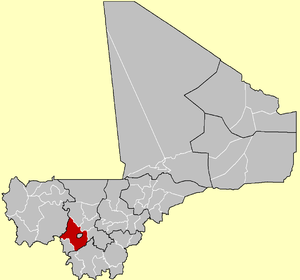Kati Cercle
Kati Cercle is an administrative subdivision of the Koulikoro Region of Mali. Its seat is the town of Kati, which is also its largest town. It lies at the southwest corner of the region, and completely surrounds the Bamako Capital District. Until the capital was hived off in 1977, the combined Cercle was called Bamako Cercle, with the capital city as its seat.
Kati | |
|---|---|
 Location of Kati Cercle in Mali | |
| Country | |
| Region | Koulikoro Region |
| Admin HQ (Chef-lieu) | Kati |
| Area | |
| • Total | 16,896.61 km2 (6,523.82 sq mi) |
| Population (2009 census)[1] | |
| • Total | 948,128 |
| • Density | 56.11/km2 (145.3/sq mi) |
| Time zone | UTC+0 (GMT) |
Kati Cercle is home to primarily Bambara and Malinke farmers, as well as Bozo and Fula populations. The Kati area formed part of the pre-colonial Beledougou region of the Mali Empire, Bambara Empire, and was amongst the first places colonised by the French in the last decade of the 19th century.
The Cercle falls largely south of the dryer Sahel land, in the wetter Sudan. Through it runs the fertile valley of the Niger River, home to groundnut, cotton, and tobacco farms, as well as being a major transportation and fishing resource.
Administrative subdivisions
The Kati Cercle is divided into 37 communes:[2]
- Baguinéda-Camp
- Bancoumana
- Bossofala
- Bougoula
- Daban
- Diago
- Dialakoroba
- Dialakorodji
- Diédougou
- Dio-Gare
- Dogodouman
- Dombila
- Doubabougou
- Faraba
- Kalabancoro
- Kalifabougou
- Kambila
- Kati
- Kourouba
- Mandé
- Moribabougou
- Mountougoula
- N'Gabacoro
- N'Gouraba
- N'Tjiba
- Niagadina
- Nioumamakana
- Ouélessébougou
- Safo
- Sanankoro Djitoumou
- Sanankoroba
- Sangarébougou
- Siby
- Sobra
- Tiakadougou-Dialakoro
- Tiélé
- Yélékébougou
References
- Resultats Provisoires RGPH 2009 (Région de Koulikoro) (PDF) (in French), République de Mali: Institut National de la Statistique, archived from the original (PDF) on 2011-07-22
- Communes de la Région de Koulokoro (PDF) (in French), Ministère de l’administration territoriale et des collectivités locales, République du Mali, archived from the original (PDF) on 2012-03-09.

